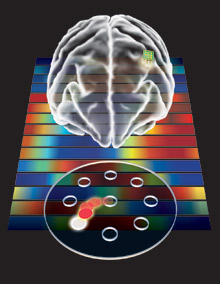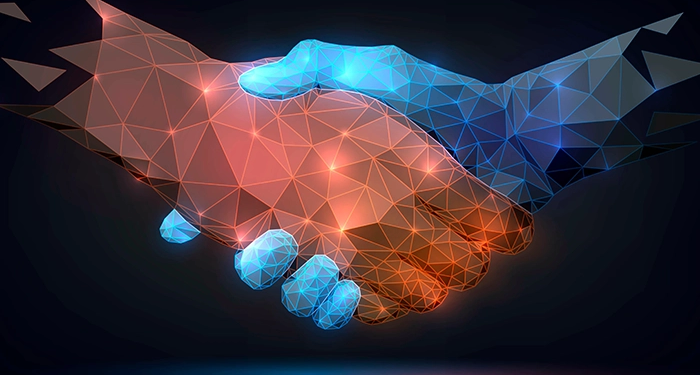
In experiments that involved moving a cursor from a central starting point to a nearby target, researchers found that the brain is capable of creating a stable mental representation of a disembodied device. © John Blanchard illustration
“Practice makes perfect” is the maxim drummed into students struggling to learn a new motor skill, be it riding a bike or developing a killer backhand in tennis. New research from the University of California, Berkeley, (UC Berkeley) now reveals that the brain can also achieve this motor memory with a prosthetic device, providing more hope that people can one day master control of artificial limbs with greater ease.
The study, published July 21 in the open-access journal PLoS Biology, addressed a fundamental question about whether the brain can establish a stable neural map of a motor task to make control of an artificial limb more intuitive. In the study, macaque monkeys used brain signals to move a computer cursor to various targets. The researchers, led by Jose Carmena, PhD, learned that the brain could develop a mental map of a solution to achieve the task with high proficiency, and that it adhered to that neural pattern without deviation, much like a driver sticks to a given route commuting to work.
Automatic Movements
“When your own body performs motor tasks repeatedly, the movements become almost automatic,” said Carmena, a UC Berkeley assistant professor with joint appointments in the department of electrical engineering and computer sciences, the Helen Wills Neuroscience Institute, and the program in cognitive science. “The profound part of our study is that this is all happening with something that is not part of one’s own body. We have demonstrated that the brain is able to form a motor memory to control a disembodied device in a way that mirrors how it controls its own body. That has never been shown before.”
Researchers in the field of brain-machine interfaces, including Carmena, have made significant strides in recent years in the effort to improve the lives of people with physical disabilities. An April 2009 survey by the Christopher and Dana Reeve Foundation found that nearly 1.3 million people in the United States suffer from some form of paralysis caused by spinal cord injury. When other causes of restricted movement are considered, such as stroke, multiple sclerosis, and cerebral palsy, the number of Americans with paralysis jumps to 5.6 million, the survey found.
In previous experiments that involved moving a cursor from a central starting point to a nearby target, researchers found that the brain is capable of creating a stable mental representation of a disembodied device.
Researchers have demonstrated that rodents, non-human primates, and humans are able to control robotic devices or computer cursors in real time using only brain signals. But what had not previously been clear was whether such a skill had been consolidated as a motor memory. The new study suggests that the brain is capable of creating a stable mental representation of a disembodied device so that it can be controlled with little effort.
To demonstrate this, Carmena and Karunesh Ganguly, PhD, a post-doctoral fellow in Carmena’s laboratory, used a mathematical model, or “decoder,” that remained static during the length of the study, and they paired it with a stable group of neurons in the brain. The decoder, analogous to a simplified spinal cord, translated the signals from the brain’s motor cortex into movement of the cursor.
Practice Makes Perfect
It took about four to five days of practice for the monkeys to master precise control of the cursor. Once they did, they completed the task easily and quickly for the next two weeks.
As the tasks were being completed, the researchers monitored the changes in activity of individual neurons involved in controlling the cursor. They could tell which cells were firing when the cursor moved in specific directions. The researchers noticed that when the animals became proficient at the task, the neural patterns involved in the “solution” stabilized.
“The solution adopted is what the brain returned to repeatedly,” Carmena said.
That stability is one of three major features scientists associate with motor memory, and it is all too familiar to music teachers and athletic coaches who try to help their students “unlearn” improper form or techniques, because once a motor memory has been consolidated, it can be difficult to change.
Other characteristics of motor memory include the ability for it to be rapidly recalled upon demand and its resistance to interference when new skills are learned. All three elements were demonstrated in the UC Berkeley study.
In the weeks after they achieved proficiency, the primates exhibited rapid recall by immediately completing their learned task on the first try. “They did it from the get-go; there was no need to retrain them,” Carmena said.
Real-life examples of resistance to interference, the third feature of motor memory, include people who return to an automatic transmission car after learning how to drive stick-shift. In the study, the researchers presented a new decoder-marked by a different colored cursor-two weeks after the monkeys showed mastery of the first decoder.
As the monkeys were mastering the new decoder, the researchers would suddenly switch back to the original decoder and saw that the monkeys could immediately perform the task without missing a beat. The monkeys could easily switch back and forth between the two decoders, showing a level of neural plasticity never before associated with the control of a prosthetic device, the researchers said.
“This is a study that says that maybe one day, we can really think of the ultimate neuroprosthetic device that humans can use to perform many different tasks in a more natural way,” Carmena said.
An Important Stride, but Not an Evolutionary One
However, the researchers acknowledged that prosthetic devices will not match what millions of years of evolution have accomplished to enable animal brains to control body movement. The complexity of wiring one’s brain to properly control the body is made clear whenever one watches an infant’s haphazard attempts to find its own hands and feet.
“Nevertheless, beyond its clinical applications, which are very clear, this line of research sheds light on how the brain assembles and organizes neurons, and how it forms a motor memory to control the prosthetic device,” Carmena said. “These are important, fundamental questions about how the brain learns in general.”
The study was supported by the Christopher and Dana Reeve Foundation, the American Heart Association, and the American Stroke Association.




